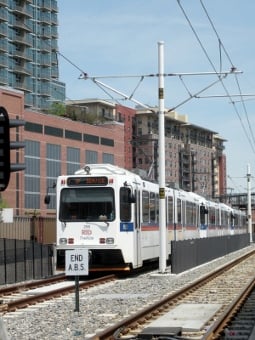A good question to ask of public transportation is how effective is it at fighting pollution. Where poor air quality is present, affected town residents may be interested in knowing if investing further in transit will encourage more people to use transit and, provided it does, if that will lead to a marked reduction in transportation emissions overall. The answer for each region or corridor will, of course, be different.
It would be helpful if this type of information could be quantified so as to provide a clear idea of just what is being talked about here. On that note, one recently released report and calculating tool could prove extremely helpful in this regard. Known as: “Quantifying Transit’s Impact on GHG Emissions and Energy Use—The Land Use Component,” the tool and report are from the Transportation Research Board’s Transit Cooperative Research Program.
In the aptly named “New tool estimates transit’s effect on VMT and emissions” news article, according to State Smart Transportation Initiative (SSTI) Managing Director Eric Sundquist, the report and tool fills a gap between the roles transit plays in raising urban land-use densities and lowering traffic and exhaust emissions coupled to that.

Moreover, the tool calculates by corridor or by region what affect added surface roadway and freeway lane-miles have. According to documented research in the report, by adding freeway and roadway lane-miles, this not only increases the amount of vehicle travel miles, but increased consumption in energy and emissions of greenhouse gases (GHG), too, Sundquist was quick to point out.
The SSTI managing director uses Madison, Wisconsin as a case in point. That is to say, a decrease of just 10 percent in transit service would cause a 13-million-pound (6,500 ton) increase in GHG, while a 10 percent decrease in highway lane-miles, meanwhile, would correspondingly lead to a 69-million-pound (34,500 ton) GHG reduction.
It follows then that the next question to ask would have to do with what type of transit (roadway- or railway-based) is better at facilitating urban population densification.
For perspective, turned to is the 2004 reference: The New Transit Town: Best Practices in Transit-Oriented Development. In this book it is made abundantly clear that equal being all other things, railway-based transit attracts development that is more intense. This claim is supported by a pointed example.1
![Soybeanbus[1]](https://alankandel.scienceblog.com/files/2012/12/Soybeanbus1-300x193.jpg)
When looking at rail- versus road-based transit options, while ridership is indeed a very import metric to take into consideration, it is not the only one. It is important to ask also for what other purpose will transit serve. Also, the construction and operating costs for railway- and roadway-based systems are indeed different. That said, based on transit system need, it is important to have a clear understanding as to what mode will bring the greater or greatest value.
Transit can act as a catalyst to increase pedestrian and transit-oriented-development activity, and that can translate into greater densification around stations and along corridors, which, in turn, can help promote ridership potential not to mention helping suppress air-pollutant emissions.
Notes
- Hank Dittmar and Shelley Poticha, “Defining Transit-Oriented Development: The New Regional Building Block,” sidebar section “A Note About Transit Technologies,” pp. 36, 37 in The New Transit Town: Best Practices in Transit-Oriented Development, Hank Dittmar and Gloria Ohland, ed., 2004.
Published by Alan Kandel